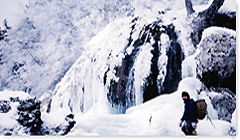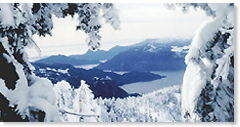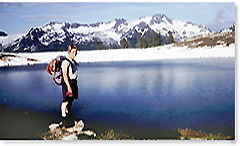|
 Avalanche
Prevention Avalanche
Prevention
Avalanche
Accident Prevention and Personal Safety in the Backcountry:
By Peter Austen
You may
be a skier, snowboarder or snowmobiler or you just love to hang around
in the snow. You must have some knowledge of what is happening in the
snowpack if you intend to move across it. You must carry a good strong
shovel and an avalanche beacon that you know how to use.
Snow:
The main problem with snow is that it forms layers while different snowfalls
accumulate over the winter. Taking a basic one-day avalanche course
is essential but there are several tests you can do to determine the
stability of the snowpack.
1.
Push a ski pole into the snow, if you feel increasing resistance and
the pole does not suddenly break through in places the chances are that
the slope is fairly stable. If the pole suddenly breaks through then
you have hit an unstable layer.
 2.
If you suspect layers, dig a pit about five feet deep. This is the depth
of snowpack that will affect you. Isolate a one-foot square block and
put your shovel in the back of this down to about one-foot. Gently pull
without levering. The block will probably slide on a layer. Repeat the
test going further down behind the block. From this you can tell roughly
how stable the snowpack is. 2.
If you suspect layers, dig a pit about five feet deep. This is the depth
of snowpack that will affect you. Isolate a one-foot square block and
put your shovel in the back of this down to about one-foot. Gently pull
without levering. The block will probably slide on a layer. Repeat the
test going further down behind the block. From this you can tell roughly
how stable the snowpack is.
3. If the snow is unstable do a rutschblock. Rutsch means,
"slip." In this test you isolate a six-foot square block and jump on
it with increasing force until it breaks. If it breaks too easily go
home or stay in thickly treed areas.
 Causes
of Instability in the Snowpack are: Causes
of Instability in the Snowpack are:
1.
Surface hoar, which is essentially frozen dew. If more snow falls on
top of this the slope may fail.
2. Depth hoar, which is unstable crystals at ground level.
3. Rain, which goes through the snow and weakens the layers.
4. Effects of wind and sun, which cause loaded slopes
of soft windslab.
Hints
to Avoid Avalanches:
Remember that
1.
Most avalanches are caused by people.
2. Stay away from cornices (overhanging snow) both above
and below.
3. When it has snowed nine inches or more in a twenty-four
hour period stay out of the mountains for forty-eight hours to allow
the snow to consolidate.
4. Call the Avalanche Hotline 1-800-667-1105 or the Canadian
Avalanche Association website for up to date information. Even a moderate
avalanche rating means using extreme caution.
5. If you have any doubt about the stability of a slope
do not go on it.
6. Stay in treed areas or on ridges
What
to do if caught in an Avalanche:
1.
Do not panic
2.
Clear an airspace
3.
Do a butterfly swimming stroke
4.
Pray for salvation both on and off this earth.
If you follow the above information your chances are measurably improved.
|


 Avalanche
Prevention
Avalanche
Prevention
 2.
If you suspect layers, dig a pit about five feet deep. This is the depth
of snowpack that will affect you. Isolate a one-foot square block and
put your shovel in the back of this down to about one-foot. Gently pull
without levering. The block will probably slide on a layer. Repeat the
test going further down behind the block. From this you can tell roughly
how stable the snowpack is.
2.
If you suspect layers, dig a pit about five feet deep. This is the depth
of snowpack that will affect you. Isolate a one-foot square block and
put your shovel in the back of this down to about one-foot. Gently pull
without levering. The block will probably slide on a layer. Repeat the
test going further down behind the block. From this you can tell roughly
how stable the snowpack is. Causes
of Instability in the Snowpack are:
Causes
of Instability in the Snowpack are: